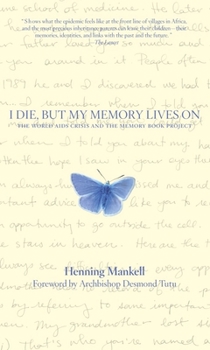I Die, But the Memory Lives on
Select Format
Select Condition 
Book Overview
"A deeply moving account of Henning Mankell's personal responses to AIDS and its victims, both parents and children left behind far too soon." --Archbishop Desmond Tutu The internationally famous creator of the bestselling Kurt Wallander mysteries tells the true story of a heartrending tradition spawned by a major health crisis: the invaluable Memory Book Project, which gives those dying of AIDS an opportunity to record their lives...
Format:Hardcover
Language:English
ISBN:1595580131
ISBN13:9781595580139
Release Date:December 2005
Publisher:New Press
Length:113 Pages
Weight:0.50 lbs.
Dimensions:0.6" x 4.9" x 7.3"
Customer Reviews
2 ratings
"I Want To Tell You How Much I Love You"
Published by Thriftbooks.com User , 16 years ago
As the Swedish mystery writer Henning Mankell traveled over Africa, he discovered Memory Books usually written by parents infected with AIDS for their children. In this slim but powerful volume he says that he read 30 of them. He has chosen to include here the memory book of a highly literate nurse left for her son Peter Kanyi. She reminds him of her family's traditions and values-- that he should respect his elders, support the needy and work hard to make a living. She closes her letter to him by declaring how much she loves him and instructs him to "keep away from AIDS." Mr. Mankell writes his own commentary-- interwoven with the nurse's words-- of how he got involved in the memory book project, some of his own fears and close escapes with death, the role that racism plays in the AIDS struggle in Africa, the myths about the disease-- that you can be cured by having intercourse with a virgin-- the greed of the drug companies. And he writes of persons he met, most notably Christine, a teacher infected with AIDS, and her daughter Aida who plants a mango tree, such a beautiful symbol of hope, in the--as Christine says so eloquently-- the mess of AIDS in Uganda. Her exact words: "'Death always makes a mess of things, no matter when it comes.'" Mr. Mankell also introduces us to Moses who has written 15 books, one for each of his children and grandchildren. What resonates on every page of I DIE BUT MY MEMORY LIVES ON is the humanity of Mr. Mankell-- one gets that from reading his novels but it is a consolation to have it affirmed here-- and the dignity with which the people he writes about face sickness and death. "Being illiterate is not the same thing as being devoid of dignity," he says. Mr. Mankell tells a true story to Christine and her daughter Aida that occurred during the civil war in Mozambique in 1990. There he met a man, perhaps 19 or 20, whose clothes were in tatters. He was barefoot but he had painted shoes on his feet to show that he was a human being with dignity. "I learned that we should all be aware that there could come a day when we too will have to paint shoes onto our feet." Of course this is the same writer who has a character in a novel say that every friendship is a miracle. The Memory Book Project invites comparison with the Names Project, the brain child of Clive Jones in San Francisco in 1987, that has now mushroomed from a single panel to a quilt that covers six city blocks. Although different in many ways-- the quilt panels are made by family and friends of those who have died of AIDS-- both projects strive to keep alive the memories of the fallen. If you think you cannot read yet another book about AIDS, this one may surprise you. Archbishop Desmond Tutu, another great humanitarian, writes in a foreword that by "encouraging parents to recall their life stories, not just for their children, but also for humanity, Henning Mankell has given a great gift to the world." Indeed he has.
I Die, But My Memory Lives On
Published by Thriftbooks.com User , 17 years ago
Title: I Die, But My Memory Lives On Author: Henning Mankell Summary: AIDS. It's a terrifying and deadly disease. In the book a few of its many victims share the way that it has affected them. Some fail to protect themselves, while others were affected through the deaths of their loved ones. In the midst of her mother's death, a young girl named Aida raises a mango tree, an attempt to bring life in to a country filled with despair and death. In this book we enjoyed the fact that it taught us about AIDS and how people are affected by it. It has changed our perspective on AIDS in general because now we know what they think and what they are feeling. We think that this book would be better it the author shared more about their experiences with AIDS than his. We also believe that if the memory books that the victims have written were displayed at the end of the book as a separate section rather than enter twined with the story. We would recommend this book to: · Girls of the ages between 13 and 16 · And Boys of the ages of 15 and 18 We would recommend this book to those people because it is a very moving book and shocks you with the information that is given. It would be best read by more mature people because it is very moving and illustrative about how people with AIDS and their family members are affective. - Tracy, Holly, Claire-Anne, and Nicolette






